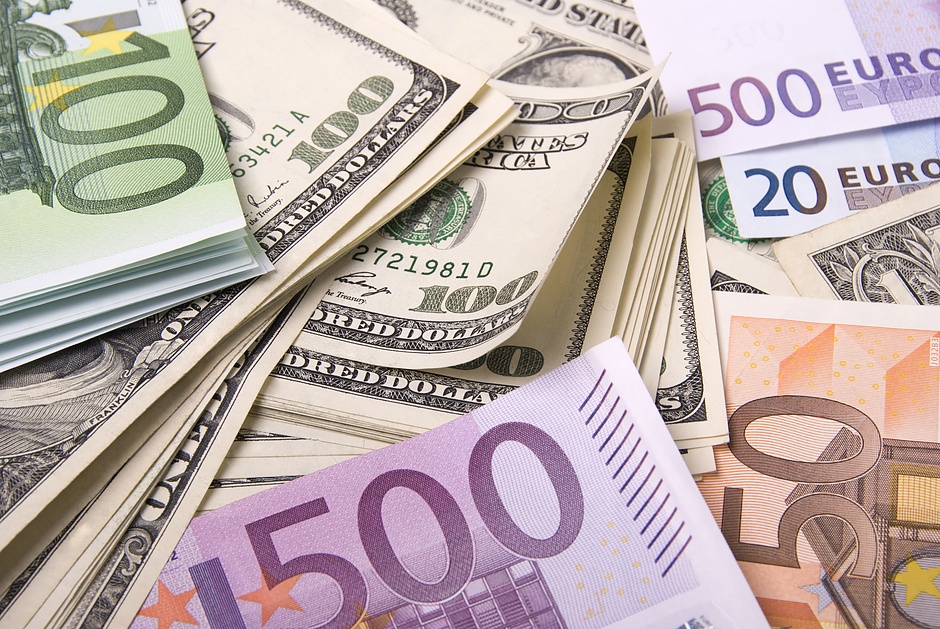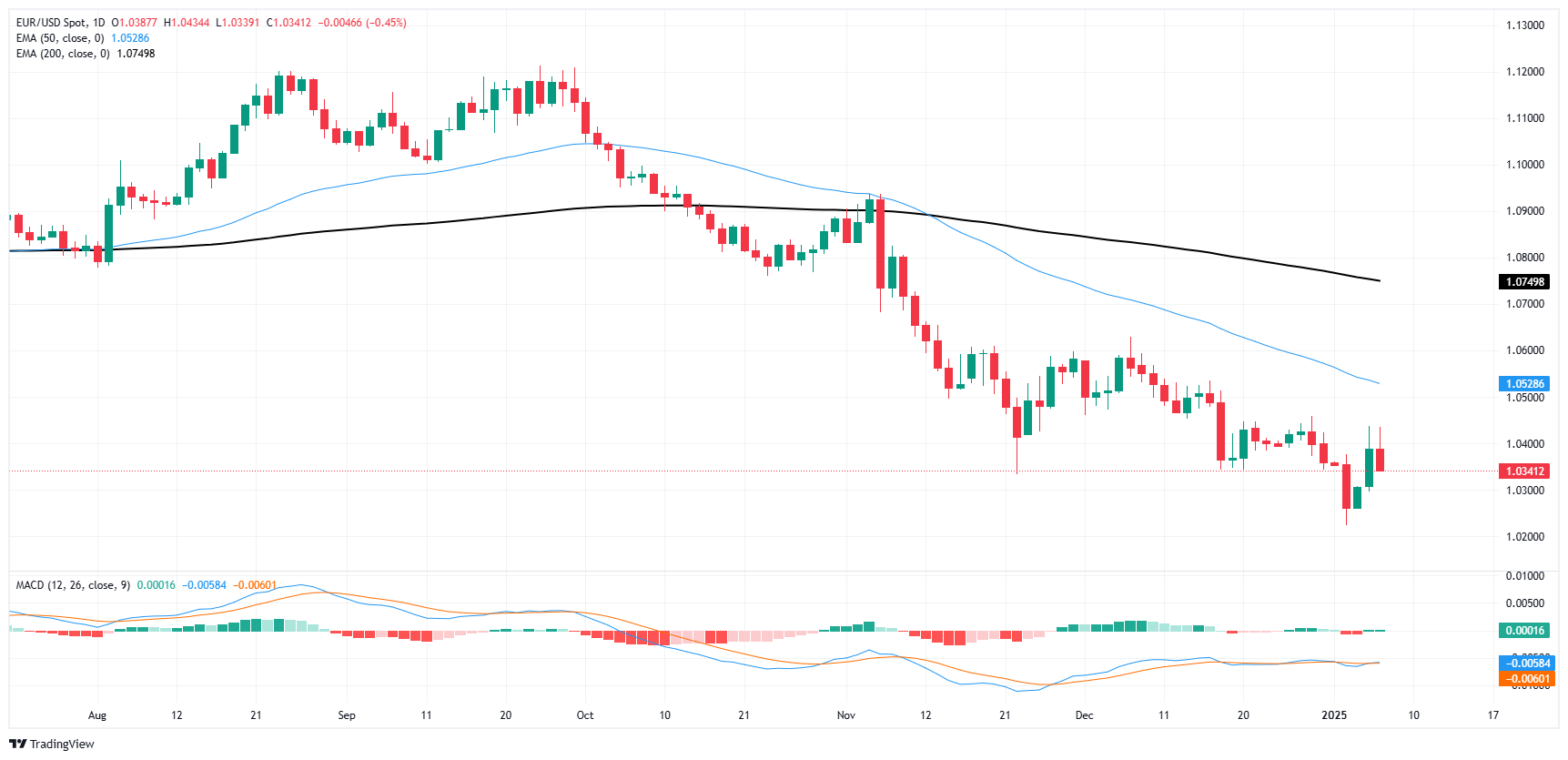Created
: 2025.01.08














![]() 2025.01.08 08:18
2025.01.08 08:18
EUR/USD turned tail and swooned against the Greenback on Tuesday, shedding four-tenths of one percent after a failed recovery of the 1.0400 handle fizzled out completely. The pair is still trading up from last week's 26-month low, but not by much. Euro bulls are in desperate need of a turnaround as Fiber continues to grind its way back toward 1.0200.
European Harmonized Index of Consumer Prices (HICP) inflation came in about as expected, with annualized HICP for the year ended in December ticking upwards slightly to 2.4% YoY from the previous 2.2%. However, most of the upward pressure in European inflation figures appears to be either baked into older numbers, or is non-structural ticket items, giving Euro traders some hope that things will continue to improve.
On the US side, ISM Services Purchasing Managers Index (PMI) business activity survey results came in much hotter than expected, as did ISM Services Prices Paid. Both figures were for the month of December, igniting fresh market concerns that the Federal Reserve (Fed) may not be able to deliver near as many rate cuts in 2025 as investors had initially hoped.
Early Wednesday, German Retail Sales and pan-EU Producer Price Index (PPI) inflation data are set to be released, with market forecasts indicating a robust rebound in both metrics. Meanwhile, in the US, December ADP Employment Change figures and the latest Meeting Minutes from the Fed are scheduled for release during the upcoming trading session. The ADP employment figures are seen as an unreliable predictor of what Friday's Nonfarm Payrolls (NFP) data may reveal, but traders won't let that stop them from overreacting to large deviations from forecasts. Investors will be looking for any signs that could point to a potential rate cut before June, which would include a pronounced, but not too severe, softening in the labor market.
EUR/USD continues to churn on the low side as the US Dollar remains the market's favored jumping-in point. The pair has shed a little over 6.5% since peaking just above 1.0900 in early November, chalking in a clean technical rejection from the 200-day Exponential Moving Average (EMA) which is now grinding its way down into the 1.0700 handle. Fiber bulls hoping to cement in a fresh bull run from multi-year lows will need to first contend with the 50-day EMA, which is descending into 1.0500.

The Euro is the currency for the 19 European Union countries that belong to the Eurozone. It is the second most heavily traded currency in the world behind the US Dollar. In 2022, it accounted for 31% of all foreign exchange transactions, with an average daily turnover of over $2.2 trillion a day. EUR/USD is the most heavily traded currency pair in the world, accounting for an estimated 30% off all transactions, followed by EUR/JPY (4%), EUR/GBP (3%) and EUR/AUD (2%).
The European Central Bank (ECB) in Frankfurt, Germany, is the reserve bank for the Eurozone. The ECB sets interest rates and manages monetary policy. The ECB's primary mandate is to maintain price stability, which means either controlling inflation or stimulating growth. Its primary tool is the raising or lowering of interest rates. Relatively high interest rates - or the expectation of higher rates - will usually benefit the Euro and vice versa. The ECB Governing Council makes monetary policy decisions at meetings held eight times a year. Decisions are made by heads of the Eurozone national banks and six permanent members, including the President of the ECB, Christine Lagarde.
Eurozone inflation data, measured by the Harmonized Index of Consumer Prices (HICP), is an important econometric for the Euro. If inflation rises more than expected, especially if above the ECB's 2% target, it obliges the ECB to raise interest rates to bring it back under control. Relatively high interest rates compared to its counterparts will usually benefit the Euro, as it makes the region more attractive as a place for global investors to park their money.
Data releases gauge the health of the economy and can impact on the Euro. Indicators such as GDP, Manufacturing and Services PMIs, employment, and consumer sentiment surveys can all influence the direction of the single currency. A strong economy is good for the Euro. Not only does it attract more foreign investment but it may encourage the ECB to put up interest rates, which will directly strengthen the Euro. Otherwise, if economic data is weak, the Euro is likely to fall. Economic data for the four largest economies in the euro area (Germany, France, Italy and Spain) are especially significant, as they account for 75% of the Eurozone's economy.
Another significant data release for the Euro is the Trade Balance. This indicator measures the difference between what a country earns from its exports and what it spends on imports over a given period. If a country produces highly sought after exports then its currency will gain in value purely from the extra demand created from foreign buyers seeking to purchase these goods. Therefore, a positive net Trade Balance strengthens a currency and vice versa for a negative balance.
![]()
Created
: 2025.01.08
![]()
Last updated
: 2025.01.08

FXStreet is a forex information website, delivering market analysis and news articles 24/7.
It features a number of articles contributed by well-known analysts, in addition to the ones by its editorial team.
Founded in 2000 by Francesc Riverola, a Spanish economist, it has grown to become a world-renowned information website.
We hope you find this article useful. Any comments or suggestions will be greatly appreciated.
We are also looking for writers with extensive experience in forex and crypto to join us.
please contact us at [email protected].
Disclaimer:
All information and content provided on this website is provided for informational purposes only and is not intended to solicit any investment. Although all efforts are made in order to ensure that the information is correct, no guarantee is provided for the accuracy of any content on this website. Any decision made shall be the responsibility of the investor and Myforex does not take any responsibility whatsoever regarding the use of any information provided herein.
The content provided on this website belongs to Myforex and, where stated, the relevant licensors. All rights are reserved by Myforex and the relevant licensors, and no content of this website, whether in full or in part, shall be copied or displayed elsewhere without the explicit written permission of the relevant copyright holder. If you wish to use any part of the content provided on this website, please ensure that you contact Myforex.
Myforex uses cookies to improve the convenience and functionality of this website. This website may include cookies not only by us but also by third parties (advertisers, log analysts, etc.) for the purpose of tracking the activities of users. Cookie policy